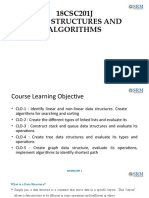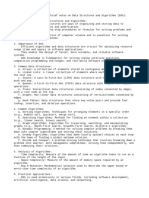0% found this document useful (0 votes)
36 views2 pagesData Structures
Data structures and algorithms are essential concepts in computer science, where data structures organize data efficiently and algorithms provide step-by-step processes for tasks. Common data structures include arrays, linked lists, stacks, queues, trees, and graphs, while algorithms encompass sorting, searching, recursion, dynamic programming, and graph algorithms. Mastery of these topics enhances software performance, scalability, and problem-solving skills.
Uploaded by
Marija StojkovskaCopyright
© © All Rights Reserved
We take content rights seriously. If you suspect this is your content, claim it here.
Available Formats
Download as DOCX, PDF, TXT or read online on Scribd
0% found this document useful (0 votes)
36 views2 pagesData Structures
Data structures and algorithms are essential concepts in computer science, where data structures organize data efficiently and algorithms provide step-by-step processes for tasks. Common data structures include arrays, linked lists, stacks, queues, trees, and graphs, while algorithms encompass sorting, searching, recursion, dynamic programming, and graph algorithms. Mastery of these topics enhances software performance, scalability, and problem-solving skills.
Uploaded by
Marija StojkovskaCopyright
© © All Rights Reserved
We take content rights seriously. If you suspect this is your content, claim it here.
Available Formats
Download as DOCX, PDF, TXT or read online on Scribd
/ 2























































